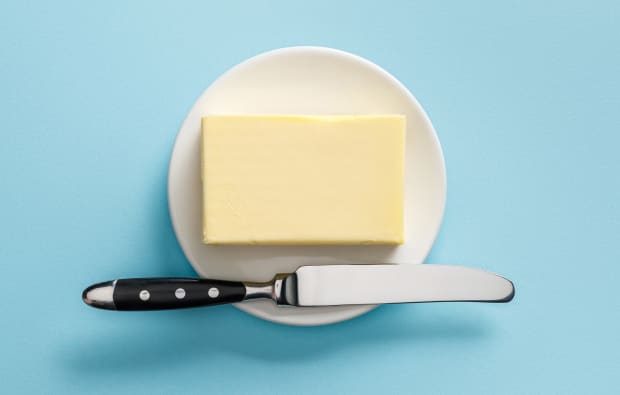- Like
- SHARE
- Digg
- Del
- Tumblr
- VKontakte
- Flattr
- Buffer
- Love This
- Save
- Odnoklassniki
- Meneame
- Blogger
- Amazon
- Yahoo Mail
- Gmail
- AOL
- Newsvine
- HackerNews
- Evernote
- MySpace
- Mail.ru
- Viadeo
- Line
- Comments
- Yummly
- SMS
- Viber
- Telegram
- JOIN
- Skype
- Facebook Messenger
- Kakao
- LiveJournal
- Yammer
- Edgar
- Fintel
- Mix
- Instapaper
- Copy Link
Q: To me, there’s nothing better than mushrooms sautéed in butter, or buttered broccoli, or butter melted on a muffin! However, I’ve repeatedly heard that we should avoid saturated fats like butter. Should butter be avoided or not?
We all grew up hearing that butter should be avoided because it’s a saturated fat that isn’t good for heart health. However, the saturated fat myth has been thoroughly debunked in recent years: two massive review studies showed there is no association between saturated fat consumption and heart disease. (This is especially true if the saturated fat you eat doesn’t go hand-in-hand with sugar and refined grains.)
But bear in mind that all butter isn’t created equal. Just as grass-fed beef has a much stronger nutritional profile and offers more health benefits than conventional beef from cattle that are fed grains, the same is true of grass-fed butter. This is the type of butter that comes from the milk of cows that graze on grass their entire lives.
The Benefits of Grass-Fed Butter
Grass-fed butter was a historically used fat. It was part of the diets of many traditional cultures, and in many ways, it was considered a superfood. We now know that it’s rich in numerous hard-to-obtain and not so well-known nutrients and healthful fats—a key reason why some people, such as keto diet followers, are now adding it to their coffee. Here’s a rundown of the nutrients found in this creamy, golden favorite.
CLA
Grass-fed butter is a rich source of conjugated linoleic acid (CLA): It actually contains five times more CLA than butter from grain-fed cows. CLA is a beneficial fatty acid that has anti-inflammatory properties and is linked to fighting cancer and helping your body build muscle rather than store fat.
CLA also seems to promote cardiovascular health. One study conducted in Costa Rica, where most dairy farms are still pasture-based, found that people with higher CLA levels in their bodies also had less risk of heart attacks. Those with the highest levels of CLA had a 36 percent lower risk of heart attack compared to those with the lowest levels.
“Activator X”/Vitamin K2
In the 1930s, researcher Weston A. Price documented the diets of traditional cultures with little degenerative disease and very low rates of tooth decay and cavities. Price discovered that butter was an important food for bone and dental health and he deduced that it had something he called “Activator X” that helps the body use other vitamins to strengthen bones and teeth. Today many nutrition professionals think Activator X is Vitamin K2, which is found in grass-fed butter.
Vitamin K2 plays a key role in bone and heart health by regulating calcium levels. Vitamin K2 helps remove excess calcium from your bloodstream, which may help prevent harmful calcium deposits and plaque from building up in your blood vessels. The nutrient also helps your bones properly use vitamins A and D. Vitamin K2 is mainly found in fermented foods and animal products, including grass-fed butter. Our gut flora can make Vitamin K2 from Vitamin K1, which is found in vegetables. But cows that eat grass rich in K1 are much more efficient converting it to Vitamin K2, and the K2 is present in their milk and concentrated in butter made from the milk.
Omega-3 Fatty Acids
Compared to butter from grain-fed cows, grass-fed butter is a good source of omega-3 fatty acids such as DHA and EPA. One analysis found that grass-fed butter provides about 26 percent more omega-3 fatty acids than regular butter, on average.
Omega-3s are an integral part of cell membranes throughout your body and a building block for hormones. They also have anti-inflammatory functions, which are important in controlling inflammatory health conditions such as arthritis and eczema and in protecting heart and brain function.
Butyrate
Grass-fed butter contains butyrate, a short-chain fatty acid that has anti-inflammatory, metabolism-boosting, and possibly weight-controlling benefits. In studies using mice, butyrate improved insulin sensitivity, reduced cholesterol, and increased fat burning and mitochondrial activity. Mitochondria power every cell in your body, helping turn the foods you eat into cellular energy. According to a study in World Journal of Gastrointestinal Pathophysiology, butyrate can help control weight by enhancing the hormone leptin, which can suppress appetite. Butyrate also has anti-inflammatory benefits in the gut, and it may help prevent colon cancer.
Vitamins A, D, E, and Beta-Carotene
Grass-fed butter is rich in vitamins A, D, and E, which are necessary for immune function, reproduction, and vision. These nutrients are also involved in maintaining healthy teeth, bones, and skin.
Additionally, grass-fed butter contains higher amounts of beta carotene than regular butter. Beta carotene is a potent antioxidant that has been linked to a reduced risk of several chronic diseases and the body converts it to vitamin A as needed.
In sum, grass-fed butter is a nutritional powerhouse. So, go ahead and enjoy butter, but make sure you upgrade it.
If Dairy Bothers You …
Many people who are lactose-intolerant or sensitive to the proteins in milk products often can tolerate small amounts of grass-fed butter in their diet. That’s because grass-fed butter is mostly fat, with very low levels of the milk sugar and milk proteins that make other dairy foods problematic for some people.
However, we all are biochemically unique. If you are sensitive to butter, try grass-fed ghee, also called clarified butter. Ghee is made by heating butter at a very low heat until the water evaporates and then skimming off the proteins that float on top to get almost pure fat with even fewer milk sugars and proteins. Being almost pure fat, it has a higher smoke point than butter. Brands of grass-fed ghee to look for include Bulletproof Grass-Fed Ghee, Pure Indian Foods Grass-Fed Cultured Ghee, and Organic Valley Organic Ghee Clarified Butter.
If you don’t tolerate ghee, or if you avoid animal products, switch to coconut oil. It does not have the same nutritional profile as grass-fed butter, but coconut oil serves as a handy vegan substitute for butter in cooking and baking.
How to Find Grass-Fed Butter
Several imported brands of butter that are grass-fed or mostly grass-fed can be found in natural food stores. These include Anchor (from New Zealand), Kerrygold (from Ireland), Allgau (from Germany), and Smjor (from Iceland).
One nationally available brand of grass-fed butter that is USDA Organic (meaning the cows are not given feed that is genetically modified or sprayed with synthetic chemical pesticides, and they are not given antibiotics and hormones) is Organic Valley Pasture Butter. This butter, which comes in a distinctive green package, is produced from May to September when pastures are green and lush and account for 99 percent of the cow’s feed. Fortunately, you usually can find the product year-round in many health food stores.


